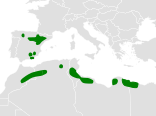| Dupont's lark | |
|---|---|
 | |
| in Lleida, Spain | |
| Scientific classification | |
| Kingdom: | Animalia |
| Phylum: | Chordata |
| Class: | Aves |
| Order: | Passeriformes |
| Family: | Alaudidae |
| Genus: | Chersophilus Sharpe, 1890 |
| Species: | C. duponti |
| Binomial name | |
| Chersophilus duponti (Vieillot, 1824) | |
 | |
| Synonyms | |
| |
Dupont's lark (Chersophilus duponti) is a species of lark in the family Alaudidae of the monotypic genus Chersophilus. It is found in northern Africa and Spain.

